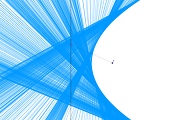2차 곡선의 회전
수학이야기/기하벡터 2017. 4. 5. 17:00$xy-1=0$은 쌍곡선이다.
이 쌍곡선을 조금 더 자세하게 알아보자. 꼭짓점 $A,B$은 직관적으로 찾을 수 있다. 초점을 찾아보자. 꼭짓점 $A(1,1)$에서 접선 $y=-x+2$이 점근선은 $x=0$과 만나는 점 $C(0,2)$라고 하면 원점이 중심이고 반지름이 $2$인 원을 그려서 초점 $F,F^{\prime}$를 찾을 수 있다. 그림에서 두 초점이 좌표축 위에 있도록 좌표축을 $45^{\circ}$ 회전한다면 점근선이 $y=\pm x$이고 초점이 $(\pm2,0)$이 쌍곡선이 될 것이므로 방정식은
$$\frac{{\sqrt 2 }^2}-\frac{{\sqrt 2 }^2}=1$$
이다. 이와 같이 좌표축을 적당히 회전하면 초점이 축 위에 있는 간단한 방정식으로 표현할 수 있다. 좌표축을 $45^{\circ}$ 회전했을 때 새로운 좌표 $(x^{\prime},y^{\prime})$와 원래 좌표 $(x,y)$ 사이에는 다음과 같은 관계가 있다. 참고 회전변환
$$\begin{pmatrix} x^{\prime}\\y^{\prime}\end{pmatrix} = \begin{pmatrix} \cos(-45^{\circ}) & -\sin(-45^{\circ}) \\ \sin(-45^{\circ}) & \cos(-45^{\circ}) \end{pmatrix} \begin{pmatrix} x\\y \end{pmatrix} =\frac{\sqrt2} {2} \begin{pmatrix} 1 & 1\\ -1 & 1 \end{pmatrix} \begin{pmatrix}x\\y \end{pmatrix}$$
다시 정리하면
$$\begin{pmatrix} x\\y\end{pmatrix} =\frac{\sqrt2}{2}\begin{pmatrix}1 & -1\\ 1& 1 \end {pmatrix} \begin{pmatrix}x^{\prime}\\y^{\prime} \end{pmatrix}$$
$$x=\frac{\sqrt2}{2}(x^{\prime}-y^{\prime}),\;\;y=\frac{\sqrt2}{2}(x^{\prime}+y^{\prime})$$
주어진 식 $xy-1=0$에 대입하면 새로운 위에서 구한 쌍곡선의 방정식을 얻을 수 있다.
일반적으로 2차방정식
$$Ax^2+Bxy+Cy^2\;\;+Dx+Ey+F=0$$은 원, 포물선, 타원, 쌍곡선을 나타낸다. 위에서 쓴 방법으로 2차곡선을 나타내는 방정식은 좌표축을 적당히 회전하여 아래와 같이 $xy$항이 존재하지 않는 꼴로 바꿀 수 있다.
$$A^{\prime}(x^{\prime} )^2+C^{\prime}(y^{\prime})^2\;\;+D^{\prime}x^{\prime}+E^{\prime}y^{\prime}+F^{\prime}=0$$
좌표축을 $\theta$ 회전했을 때 새로운 좌표 $(x^{\prime},y^{\prime})$와 원래 좌표 $(x,y)$ 사이에는 다음과 같은 관계가 있다.
$$\begin{pmatrix} x^{\prime} \\ y^{\prime} \end {pmatrix}= \begin{pmatrix} \cos(-\theta) & -\sin(-\theta) \\ \sin(-\theta) & \cos(-\theta) \end{pmatrix} \begin{pmatrix} x \\ y\end{pmatrix} $$
$$\begin{pmatrix} x \\ y\end{pmatrix}= \begin{pmatrix} \cos\theta & -\sin\theta \\ \sin\theta & \cos\theta \end{pmatrix} \begin{pmatrix} x^{\prime} \\ y^{\prime} \end{pmatrix} $$
$$x=x^{\prime} \cos\theta -y^{\prime}\sin\theta$$
$$y=x^{\prime} \sin\theta +y^{\prime}\cos\theta$$
주어진 이차방정식을 정리하자.
$$A(x^{\prime} \cos\theta -y^{\prime}\sin\theta)^2+B(x^{\prime} \cos\theta -y^{\prime}\sin\theta)(x^{\prime} \sin\theta +y^{\prime}\cos\theta)+C(x^{\prime} \sin\theta +y^{\prime}\cos\theta)^2+\cdots=0$$
여기서 $x^{\prime}y^{\prime}$항의 계수가 $0$이 되도록 하는 $\theta$를 찾아보자.
$$-2A\cos\theta\sin\theta+B(\cos^2 \theta-\sin^2 \theta) +2C \cos\theta\sin \theta=0$$
$$B(\cos^2 \theta-\sin^2 \theta) =2(A-C)\cos\theta\sin \theta$$
$$B\cos2 \theta =(A-C)\sin 2 \theta$$
$$\frac{\cos 2\theta}{\sin 2\theta}=\frac{A-C}{B}$$
정리
2차곡선 $$Ax^2+Bxy+Cy^2 +Dx+Ey+F=0$$을
$$\cot2\theta=\frac{A-C}{B}$$에서 얻어진 $\theta$만큼 좌표축을 회전하면 좌표축과 평행한 축을 가진 2차곡선으로 바꿀 수 있다.








